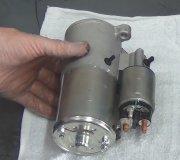History:
My car is a 2000 Lincoln Continental (with just over 42,800 miles on it). A few months ago we began having trouble with it. We could not start it and called AAA for a boost. We thought it was simply a low battery and expected no further trouble. Within a day or two we couldn't start it again. This scenario repeated 2 or 3 more times and we were told it was due to not driving the car enough. (While I don't doubt that this could cause problems, from what I was seeing I didn't believe it was the problem here). Each time this happened, errors and problem messages (Not from the OBD II port) were appearing on the "Electronic Message Center" on the car's dashboard instruments panel (see picture #1) that I knew were false and not actually happening to the car. I decided to take the battery out of the Lincoln and put in the battery from my Jeep. The car started immediately and all the error messages disappeared.
I concluded this wasn't due to the Lincoln’s battery, but the fix came about due to the time the battery was disconnected, causing false errors to clear out, at which point the car would start. (I have no idea what caused this to happen in the first place). Also, after c. 1 months the scenario repeated. I applied the same fix and it worked again. There were three of these cycles with flawless performance lasting from 1 to 2 months in between them. Each time the car started immediately and all the error messages disappeared.
Recently, my wife was driving home, and as she approached the corner of our property, the car just shut off. She lost power steering but was able to get it off the road and onto our front yard. A AAA person came but they had no clue as to what the problem was and couldn’t start the car with the booster.
After he left, I remembered something. I have a 2003 Jeep Cherokee Laredo that started having a problem over 2 years ago. Sporadically (usually away from home at nearby stores), when I got in the car to come home the car wouldn’t start. It had plenty of battery but just wouldn’t crank. This happened 3 or 4 times, and each time, after trying for quite a while, the battery started to drain and I called AAA. They would give me a boost and I got it started. One day it happened again and for some reason, I decided to try starting it in “neutral,” and it started right up. Since then, whenever this starting problem occurs in the Jeep, I immediately put it in neutral and without fail it starts right up. This has happened many dozens of times. It hit me I had tried this a couple of times with success on the Lincoln. Since I had no idea why this worked (I never even heard of a “Neutral Safety Switch - Gear Range Sensor”), I just chalked it up to the quirkiness of car behavior. But it’s a bit different this time. Shortly after AAA left I remembered and employed the start in neutral, and it did start up immediately on the first try, and all the dashboard warnings disappeared, after it ran for a while we shut it off. When we tried to start it again it wouldn’t, plus all the dashboard error messages were back. The car was outside and I wanted to get it in the garage so I tried again the next day and again it started right up and cleared the dashboard error messages. I forgot to mention I tried 3 different OBD2 scanners and none could connect, but when it started and was running I was able to connect a BlueDriver OBD2 scanner and it showed no errors. When I shut the car off it wouldn’t start again. This time I started looking for info on the internet and came across a somewhat related video by 2CarPros on YouTube. I was drawn further into the website and found “How to Test a Neutral Safety Switch - Gear Range Sensor,” (
https://www.2carpros.com/articles/how-a-neutral-safety-switch-works). Here I found that a car not starting in “Park” but starting in “Neutral” was a symptom of this part malfunctioning. I also saw, “. . .once a simple switch for the reverse lights and starter safety circuits, this switch has now become a multi-function gear position sensor which provides feedback data to the body and engine computers, all related functions are then carried through the operating system,” which (I thought) could tie into the bad error code information. Correctly or incorrectly, this was the basis for replacing this part. I am 77, on a very limited fixed income, and I thought replacing the sensor was a somewhat reasonable potshot, particularly when weighed against having to take out a “mortgage” and bring it to a dealer.
I have received the alignment tool, but which components it is to used on and how to align them is not clear from the drawings I have, and nothing comes with the tool.
The following are the messages that show on the dashboard screen:
“Gear Display Data Error”
”Check Traction Control”
“Engine Temperature Data Error”
“Fuel Flow Data Error”
“RPM Data Error.”
I have also included photos of them as they appear on the screen.
Other than showing the location of the sensor in my car, the photos aren’t particularly informative, but at least it is a starting point.
Images (Click to make bigger)
Sunday, August 4th, 2024 AT 4:55 PM

















































